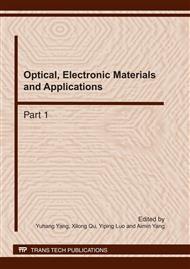p.290
p.293
p.297
p.301
p.307
p.312
p.316
p.321
p.327
Effects of Argon-Oxygen Ratio and Sputtering Power on Optical Properties of ZnO:Al Thin Films Fabricated by RF Magnetron Sputtering
Abstract:
Al-doped ZnO (ZAO) thin film with good performance was prepared by radio frequency (RF) magnetron sputtering technology under optimized process conditions. The crystallized characteristic and microstructure of the prepared samples were investigated by X-ray diffraction (XRD) pattern and atomic force microscopy (AFM). The optical transmittance spectra was employed to investigate the dependence of the optical performance of the ZAO film on the process conditions, such as argon-oxygen pressure ratios and sputtering powers, which revealed that the transmittance in the visible spectrum is first increased and then decreased as the argon/oxygen pressure ratios increased from 7/1 to 10/1. When the argon/oxygen pressure ratio is 9/1, the transmittance adds up to the maximum. In addition, as the RF sputtering power increases from 80W to 120W, the transmittance of the films is slightly declined with an average transmittance of above 80%; and with the increase of the sputtering power to 140W and 160W, the maximum transmittance of the film obviously decreases below 75%. Moreover, the electrical properties of ZAO thin films were measured by the four-probe tester. The resistivity of the film is less than 10-3 Ω • cm, demonstrating that it have a good electrical performance.
Info:
Periodical:
Pages:
307-311
Citation:
Online since:
March 2011
Authors:
Keywords:
Price:
Сopyright:
© 2011 Trans Tech Publications Ltd. All Rights Reserved
Share:
Citation:


